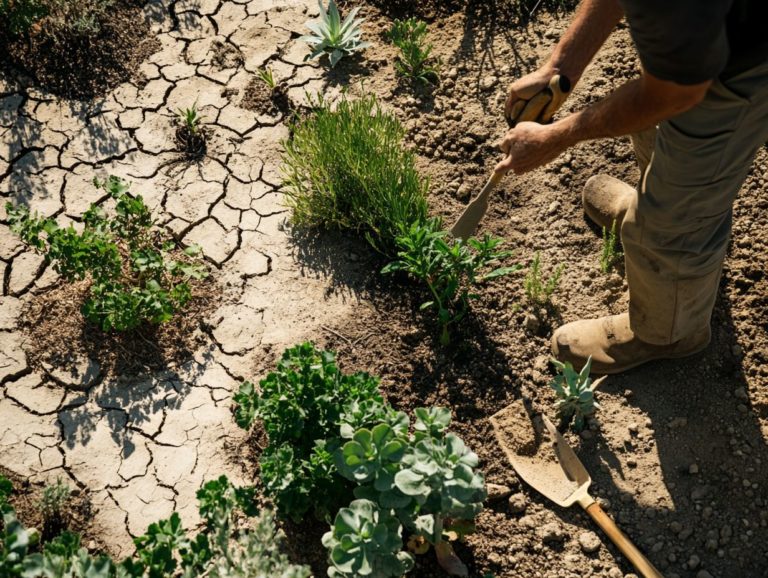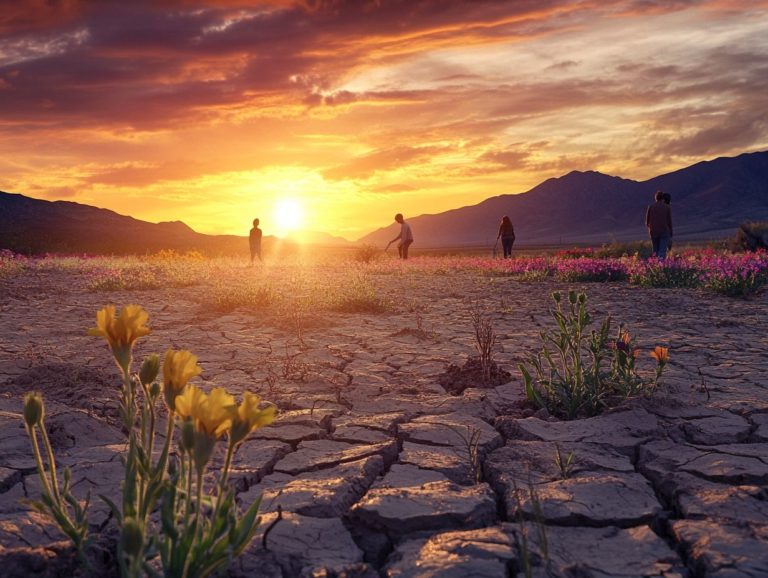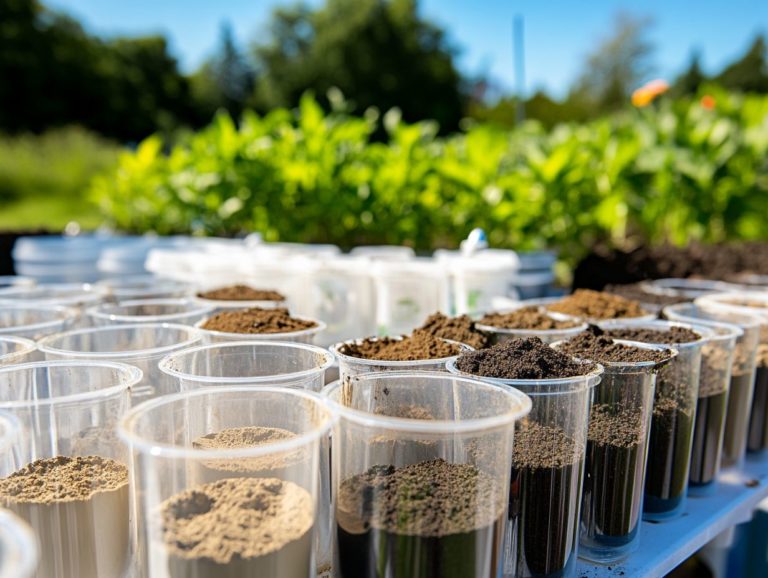Understanding Microclimates in Drought Areas
Microclimates are pivotal in shaping local ecosystems, particularly in drought-prone areas where their influence can be strikingly evident, especially in regions like the desert southwest.
This article invites you to explore the definition and characteristics of microclimates, examining how factors like the shape of the land, types of plants, and human activities come into play. You ll also discover how these unique environments impact drought conditions and find effective strategies for adapting to and managing microclimates.
Additionally, you will explore future implications and potential solutions for coexisting harmoniously with these localized climates. Join us as you uncover the intricate relationship between microclimates and drought, revealing complexities that may enhance your understanding of the environment.
Contents
- Key Takeaways:
- What is a Microclimate?
- Factors Affecting Microclimates in Drought Areas
- Impact of Microclimates on Drought
- Adapting to Microclimates in Drought Areas
- Future Considerations for Microclimates and Drought
- Frequently Asked Questions
- What is a microclimate in a drought area?
- Why is it important to understand microclimates in drought areas?
- What are some factors that can create microclimates in drought areas?
- How do microclimates in drought areas affect plant and animal life?
- Can microclimates in drought areas change over time?
- How can we use knowledge of microclimates in drought areas to mitigate the effects of drought?
Key Takeaways:
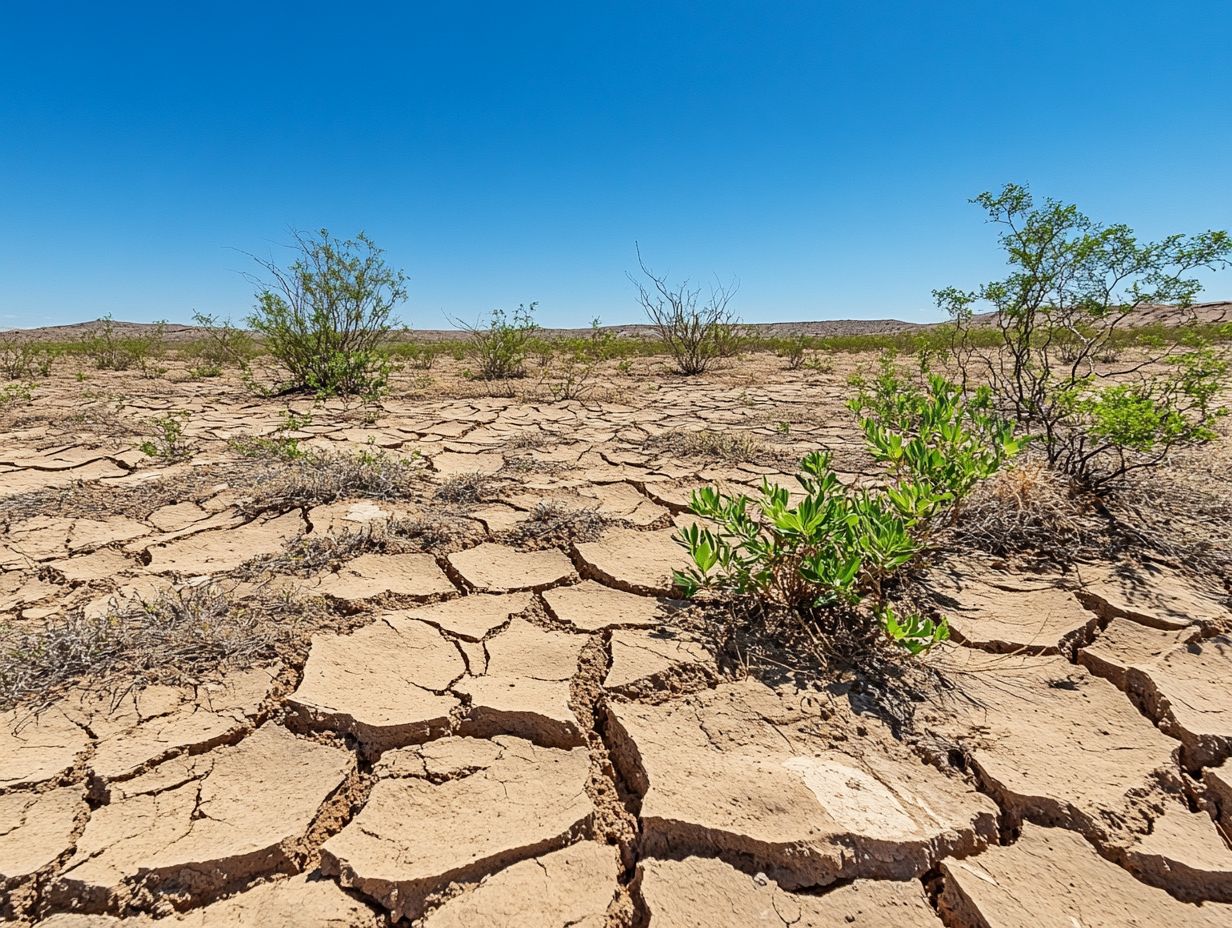
- Understanding microclimates is crucial in drought areas as they greatly impact the severity and duration of droughts, influencing factors like soil moisture and temperature variations.
- Factors such as the shape of the land, types of plants, and human activities significantly influence microclimates and can worsen drought conditions, especially in regions with different northern and southern exposures.
- Adapting to microclimates in drought areas requires strategic management and future considerations for predicting and addressing possible solutions.
What is a Microclimate?
A microclimate refers to a localized climate nestled within a broader area, shaped by elements like topography (the shape and features of the land), vegetation, and human activities. These factors lead to variations in temperature, sunlight exposure, and air circulation, all of which can profoundly influence the growth and well-being of plants in regions such as Tucson and Phoenix.
Grasping these localized conditions is essential for effective gardening and agricultural endeavors, particularly in the desert southwest and Mediterranean climates, where certain plants truly flourish.
Definition and Characteristics
Microclimates are fascinating little pockets where the climate can dramatically differ from what s happening just a stone s throw away. These areas often showcase distinct characteristics, such as temperature differences and variations in sunlight exposure.
What influences these unique climates? Factors like elevation, proximity to water bodies, and even urban structures play a significant role, creating distinct environments within surprisingly short distances. Imagine a valley cradled by mountains here, the cooler temperatures and increased moisture, thanks to the protective embrace of the peaks, create a refreshingly different atmosphere. Meanwhile, a south-facing slope basks in warmer, sun-kissed conditions, encouraging the growth of resilient, drought-tolerant plants.
In coastal regions, the ocean breezes work their magic, resulting in lush, fertile landscapes that contrast sharply with the arid terrain found just a bit further inland. These differences create vibrant ecosystems where plants and animals thrive in conditions that might otherwise seem inhospitable.
Factors Affecting Microclimates in Drought Areas
When considering microclimates in drought-prone areas, several factors come into play. Topography, vegetation, and human activities significantly contribute to the landscape.
For instance, urban heat islands areas in cities that become significantly warmer than their rural surroundings due to human activities can emerge, intensifying temperature fluctuations and disrupting air circulation. This interplay complicates water management and affects soil moisture retention, presenting distinct challenges that require thoughtful strategies.
Topography and Vegetation
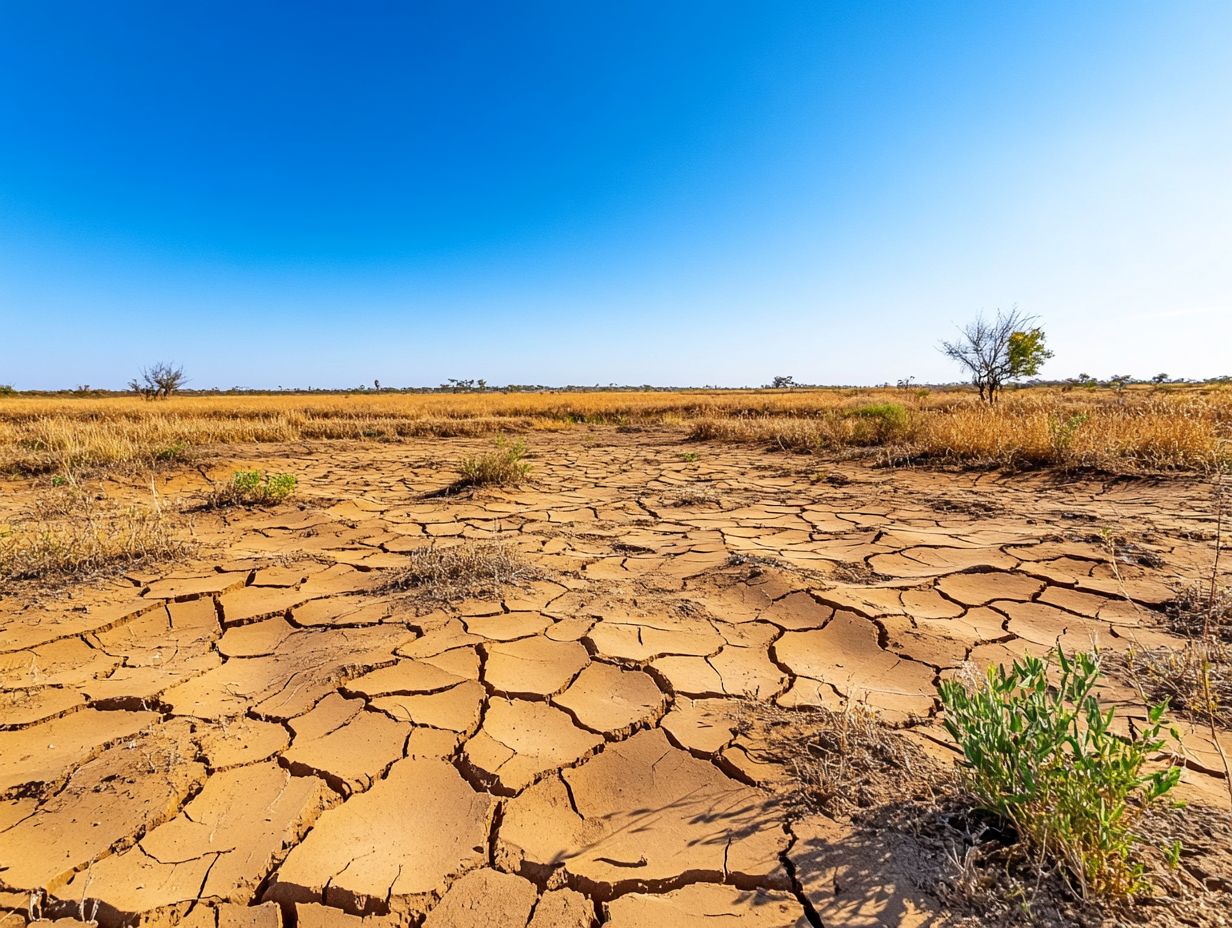
The topography of an area, including its slopes and valleys, profoundly influences the microclimate by shaping air circulation patterns and establishing distinct vegetation zones.
Take California, for instance. The Sierra Nevada mountain range plays an important role in defining local climate conditions. The western slopes bask in abundant moisture from the Pacific Ocean. This nurtures lush forests of conifers and mixed woodlands.
In stark contrast, the eastern slopes find themselves in a rain shadow, which occurs when mountains block moisture from reaching the area on the other side. This gives rise to arid deserts where unique flora have adapted to thrive in low moisture environments.
In Cape Town, Table Mountain exerts its influence over weather patterns. The coastal region enjoys a mild climate, while the mountain itself creates sharp temperature fluctuations. This results in a mosaic of diverse ecosystems.
The Fynbos vegetation, for example, flourishes in these localized conditions. It demonstrates remarkable adaptations like drought resistance, allowing it to thrive amid varying climatic influences.
Human Activities
Human activities, such as urban development and agricultural practices, can profoundly influence microclimates. They create urban heat islands and disrupt natural water management systems.
These alterations can significantly affect local weather patterns. They impact everything from temperature variations to precipitation rates. For example, rainwater harvesting a sustainable practice can enhance soil moisture levels. This effectively mitigates drought impacts and bolsters agricultural resilience.
Regions like Australia, which have embraced such strategies, have reported improved crop yields even amidst challenging climatic conditions. In densely populated areas, urban gardens can serve as vital green spaces that cool the environment and promote biodiversity.
Thoughtful human interventions can lead to positive outcomes, even in the face of pressing climate challenges.
Impact of Microclimates on Drought
Microclimates significantly influence drought conditions. They shape local water management practices and soil moisture retention. These factors are vital for sustaining plant life and ensuring agricultural success in arid regions.
Understanding the intricacies of microclimates allows you to optimize water use and enhance crop resilience. This ultimately fosters a more sustainable environment.
How Microclimates Contribute to Drought
Microclimates can play a significant role in contributing to drought. They create localized temperature variations that influence evaporation rates and, in turn, soil moisture levels. This makes it increasingly challenging for plants to thrive, particularly those that require specific sunlight shade conditions.
These small-scale environmental variations often stem from geographical features like hills, bodies of water, or even human activities. They can amplify stress on local flora. For example, in areas where concrete and asphalt absorb heat, the surrounding environment may experience elevated temperatures. This accelerates evaporation and results in drier soils.
Consequently, plants such as native wildflowers and certain tree species find it difficult to maintain their health in these harsher conditions. Grasping the dynamics of microclimates becomes essential for effective drought management.
This understanding allows you to develop tailored conservation strategies that can enhance plant resilience and improve ecosystem stability during prolonged dry spells.
Adapting to Microclimates in Drought Areas
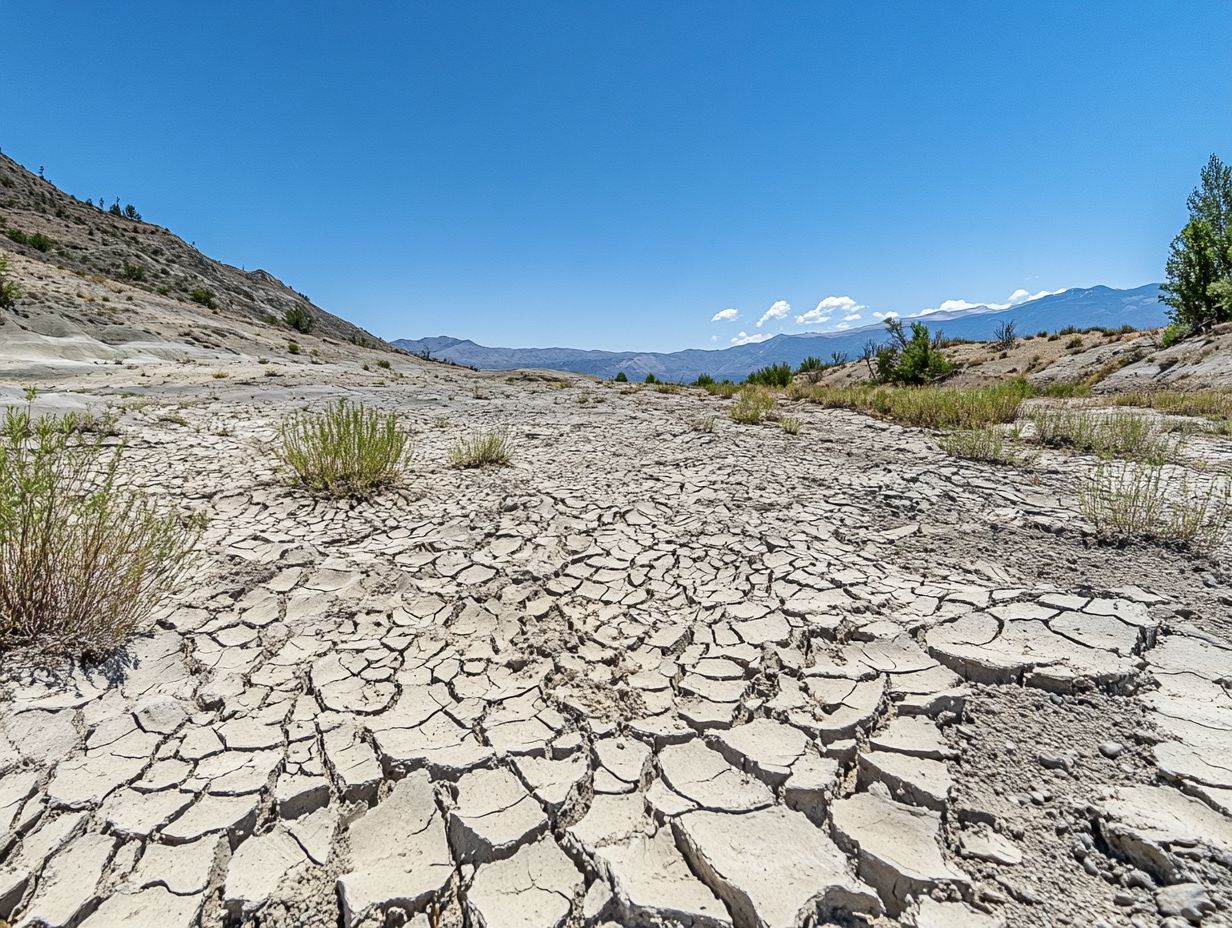
To adapt to microclimates in drought-prone areas, you can implement effective design strategies. Focus on water management techniques, rainwater harvesting, and soil modification.
These approaches will significantly enhance plant growth and resilience. They allow your garden or landscape to thrive even in challenging conditions.
Strategies for Managing Microclimates
You can manage microclimates effectively by conserving soil moisture and selecting the right native plants to optimize growth conditions.
By employing methods such as mulch application to retain soil moisture and creating contour beds to enhance water drainage, you can significantly boost your garden’s resilience. Integrating organic matter like compost enriches the soil and fosters beneficial microbial activity, promoting healthier root systems.
Choosing native plants gives you the advantage of their natural adaptation to local conditions. This means they require less water and maintenance over time.
This approach creates stunning gardens and boosts the ecosystem around you! It s a win-win for every gardening enthusiast.
Future Considerations for Microclimates and Drought
As climate change reshapes global weather patterns, consider the future of microclimates and drought with a focus on innovative microclimate design and effective water management solutions.
Anticipating how these elements will influence agricultural practices and urban planning is essential to stay ahead in this evolving landscape.
Predictions and Possible Solutions
Predictions for managing microclimates during drought suggest focusing on sustainable practices to mitigate the adverse effects of climate change on local ecosystems.
Innovative technologies, such as smart irrigation systems (automated watering systems that adjust based on weather conditions) and drone-assisted monitoring, are becoming essential tools for communities like yours that aim to optimize water usage and enhance soil health.
These solutions deliver real-time data on moisture levels and plant health, enabling you to make timely interventions that significantly reduce overall water demand.
Integrating green infrastructure think urban gardens and green roofs can dramatically lower temperatures and boost humidity levels, creating healthier microenvironments.
Embrace these innovative practices through workshops, collaboration with local governments, and partnerships with educational institutions. This gives power to you and your neighbors to actively participate in building resilience against ongoing drought conditions.
Frequently Asked Questions
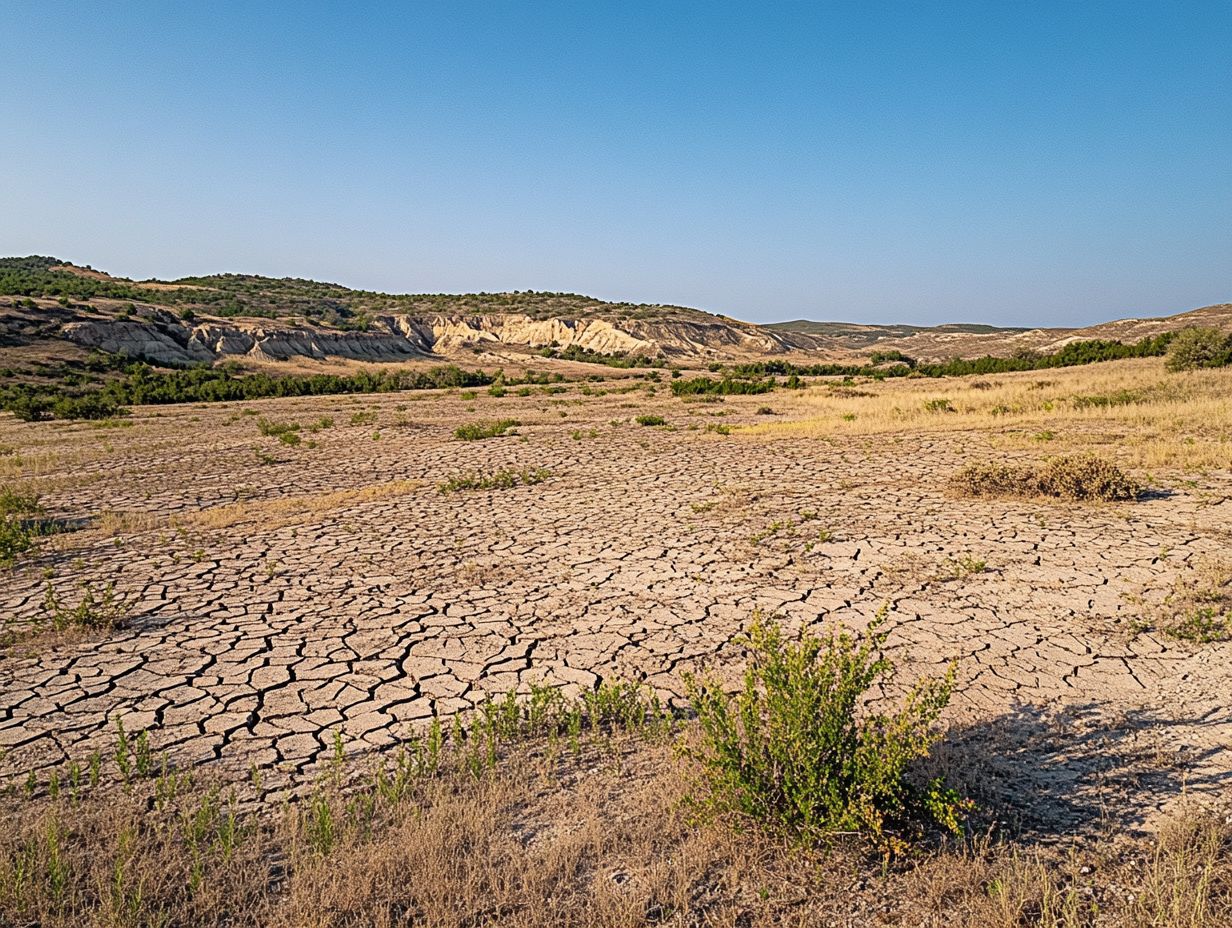
What is a microclimate in a drought area?
A microclimate in a drought area refers to a small, localized climate that differs from the overall climate of the surrounding area. It is influenced by specific factors such as topography, vegetation, and human activity. For example, in areas like Tucson and Phoenix, temperature variations can create unique microclimates.
Why is it important to understand microclimates in drought areas?
Understanding microclimates in drought areas is crucial for effective drought management and conservation efforts. It allows for targeted interventions and helps identify areas that may be more resilient to drought conditions, such as urban heat islands (areas in cities that are significantly warmer than their rural surroundings due to human activities) or regions with favorable air drainage.
What are some factors that can create microclimates in drought areas?
Microclimates in drought areas can develop due to factors like elevation, soil type, slope, and types of vegetation. Human actions, such as irrigation and land use, also contribute significantly.
The orientation of land such as eastern, western, northern, and southern exposures affects how much sunlight and shade an area receives.
How do microclimates in drought areas affect plant and animal life?
Microclimates can greatly impact the survival and growth of plants and animals. They create unique habitats that may support some species while being unsuitable for others.
Can microclimates in drought areas change over time?
Yes, microclimates can change due to factors like climate change, land use, and natural events. Monitoring these changes is vital for understanding their effects on ecosystems.
Research in regions like California and Australia, through resources such as the Mediterranean Plants Database, helps track these important variations.
How can we use knowledge of microclimates in drought areas to mitigate the effects of drought?
Understanding microclimates allows us to create targeted strategies for water conservation and protecting vulnerable species. Simple practices, like changing soil to hold water better, can make a significant difference.
This knowledge can help us take urgent action to mitigate drought effects and promote resilience in these crucial ecosystems.



